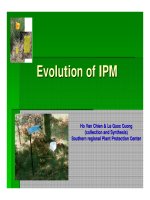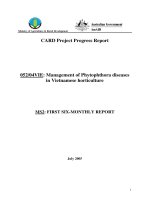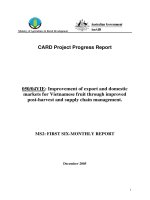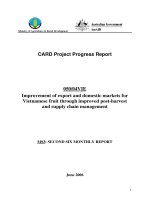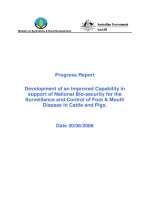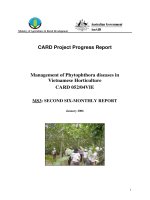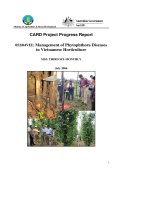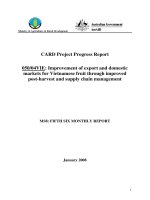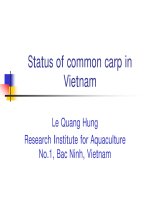Báo cáo nghiên cứu khoa học: " EFFECTS OF ULTRASOUND AND MICROWAVE IRRADIATION ON THE GREEN OXIDATION OF ALKYLARENES BY KMnO4/CuSO4 5H2O"ơ ppsx
Bạn đang xem bản rút gọn của tài liệu. Xem và tải ngay bản đầy đủ của tài liệu tại đây (343.07 KB, 6 trang )
Science & Technology Development, Vol 11, No.10 - 2008
Trang 78 Bản quyền thuộc ĐHQG-HCM
EFFECTS OF ULTRASOUND AND MICROWAVE IRRADIATION ON THE
GREEN OXIDATION OF ALKYLARENES BY KMnO
4
/CuSO
4
5H
2
O
Luu Thi Xuan Thi
(1)
, Fritz Duus
(2)
, Le Ngoc Thach
(1)
(1)University of Natural Sciences, VNU-HCM
(2)Roskilde University, Denmark
(Manuscript Received on November 18
th
, 2008, Manuscript Revised April 29
th
, 2008)
ABSTRACT: Potassium permanganate oxidized some alkylarenes such as ethylbenzene
(
1), propylbenzene (2), diphenylmethane (3), cumene (4), 1-bromo-2-phenylethane (5), indane
(
6), tetraline (7), and fluorene (8) at the benzylic position to form the corresponding aromatic
ketones under solventless reaction conditions. Under the assisstance of ultrasound and
microwave irradiation, the reaction times were reduced remarkably without a decrease of the
yield. Reaction factors including the molar ratio of substrates, KMnO
4
, CuSO
4
5H
2
O, reaction
time, microwave power were optimized to achieve the highest conversion yields and product
selectivities.
Key words: Alkylarene, oxidation, permanganate, copper sulfate pentahydrate,
ultrasound, microwave.
1.INTRODUCTION
Aromatic ketones are important intermediate products for the procurement of perfumes,
drugs, and pharmaceuticals. In recent years, the preparation of aromatic ketones by the
oxidation of alkyl groups close to an aromatic ring has been investigated in order to replace
former method based on the Friedel-Crafts reaction. Erosive and toxic waste produced by the
Friedel-Crafts acylation reaction is a main reason for improvement in synthetic ways to
aromatic ketones.
[1]
The oxidation reactions were performed under heterogeneous conditions
by KMnO
4
absorbed on CuSO
4
5H
2
O,
[2]
Al
2
O
3
,
[3]
zeolite,
[4]
montmorilonite K10.
[5]
Recently,
the solventless oxidations were performed by using dichromate ion absorbed on alumina,
[6]
or
KMnO
4
mixed with CuSO
4
5H
2
O.
[7,8]
Solventless reaction is important in Green chemistry.
[9-11]
It prevents from problems of
solvent such as charges, handling, safety and pollution. In general, the solventless reaction
gives high yield in a short time, because the oxidant is spread widely on the surface of the
solid support. Our intentions with this research are to pay attention to the reaction
stoichiometry under solventless reaction conditions and under the irradiation of ultrasound and
microwave in order to optimize the reaction conditions for each substrate, and to observe the
influences of microwave and ultrasound irradiation. Besides, manganese dioxide and copper
sulfate pentahydrate are easily collected and obtained with high yield.
1-8 1a-8a
Scheme 1. Oxidation of alkylarenes at benzylic position.
CR
1
R
2
H
H
KMnO
4
+MnO
2
+
R
1
C R
2
O
CuSO
4
5H
2
O
TẠP CHÍ PHÁT TRIỂN KH&CN, TẬP 11, SỐ 10 - 2008
Bản quyền thuộc ĐHQG-HCM Trang 79
Ethylbenzene (
1)
Propylbenzene (
2)
Diphenylmethane (
3)
2-Phenylpropane (4)
Br
1-Bromo-2-
phenylethane (
5)
Indane (6
Tetraline (7)
Fluorene (8)
O
Acetophenone (1a)
O
Propiophenone (2a)
O
Benzophenone (3a)
OH
2-Hydroxy-2-
phenylpropane (
4a)
Br
O
1-Phenyl-2-bromoethanone (
5a)
∗
Br
H
Br
1,2-Dibromo-1-phenylethane (5b)
O
1-Indanone (6a)
O
α-Tetralone (7a)
O
9-Fluorenone (8a)
Fig. 1 Structure of substrates and products in the oxidation of alkylarenes.
2.RESULTS AND DISCUSSION
The stoichiometric factor investigated on the oxidation of diphenylmethane in two
methods (microwave and ultrasound) (Fig. 2) gave evidence that the best molar ratio of
substrate, KMnO
4
, and CuSO
4
5H
2
O was 3:12:24. This ratio, observed again also for the
oxidation of indane, confirmed that it was the best molar ratio for the oxidation of alkylarenes
and arenes.
This oxidant, in the following referred to as
PP/2CSP (potassium permanganate absorbed
on a
two-fold molar amount of copper sulfate pentahydrate), was chosen as the standard
oxidant in our subsequent experiments. It should be stressed that
PP/2CSP must be prepared
as described (Experimental).
Altogether 8 alkylarenes were subjected to oxidation by
PP/2CSP under solvent-free
reaction conditions, using four different methods. In method A, fair to excellent yields were
Science & Technology Development, Vol 11, No.10 - 2008
Trang 80 Bản quyền thuộc ĐHQG-HCM
obtained under mild conditions (33-34
o
C) during long reation times (20-48 hours). Under the
assistance of ultrasound (Method B, Table 1), the reaction times were found shortened
considerably (3.5-8 hours) although the yields of the products were only slightly improved.
Microwave irradiation had no strong effect on this reaction type. The yields under
conventional heating conditions were lower than under microwave irradiation conditions.
There were some exceptional cases: i) in the case of oxidation of
5, the reaction
temperature provided by microwave or conventional heating increased the yield of
5b, ii) in
case of the oxidation of
4, the assistance of microwave or ultrasound increased the formation
of
1a by cleavage of a methyl group, and iii) 6a and 7a became over-oxidized to indan-1,3-
dione and tetrahydronapthalene-1,4-dione.
Table 1. Oxidation yield of alkylarenes following four different methods.
a
Method A Method B Method C Method D
Substrate Product
Y (%GC, t
b
) Y (%GC, t
b
)
Y (%GC, t
b∗
, P
c
) Y (%GC, t
b∗
, temp.
d
)
1 1a
62 (75, 20) 97 (100, 3.5) 58 (70, 8.7, 250) 56 (66, 8.7, 94)
2 2a
- 32 (33, 7) 38 (42, 8.1, 630) -
3 3a
87 (96, 28) 99 (100, 6) 82 (93, 7.7, 150) 83 (97, 7.7, 96)
4
4a
30 (35, 48) 36 (43, 5) 16 (26, 9.2, 350) -
0
20
40
60
80
100
3:9:22.5 3:9:36 3:12:12 3:12:24 3:12:36 3:12:48
Microwave
Ultrasound
% GC
Fig. 2 Influences of the molar ratio diphenylmethane (3):KMnO
4
:CuSO
4
5H
2
O on the efficiency
of the oxidation of diphenylmethane under solvent-free conditions and under microwave
irradiation at 240 W (for 6-8 min), or ultrasound irradiation (for 5 hours).
Molar ratio of diphenylmethane:KMnO
4
:CuSO
4
5H
2
O
TẠP CHÍ PHÁT TRIỂN KH&CN, TẬP 11, SỐ 10 - 2008
Bản quyền thuộc ĐHQG-HCM Trang 81
1a
7 (7, 48) 24 (25, 5) 10 (15, 9.2, 350) -
5a
67 (68, 48) 71 (75, 8) 30 (36, 4.8, 350) 24 (29, 4.8, 100)
5
5b
5 (7, 48) 12 (18, 8) 13 (22, 4.8, 350) 13 (22, 4.8, 100)
6 6a
14 (17, 24) 78 (84, 5) 40 (44, 4.0, 250) 20 (32, 4.0, 99)
7 7a
- 65 (73, 3) 52 (60, 10.6,
250)
40 (49, 10.6, 101)
8 8a
- 45 (52, 8) 40 (45, 12.4,
250)
32 (40, 12.4, 100)
a
Yield (Y) was calculated based on %GC. All results were optimized.
b
t = hr,
b∗
t = min.
c
P = Watt.
d
temp. =
o
C.
3.CONCLUSION
Comprehensive experimental work has demonstrated the oxidation ability of PP/2CSP to
convert alkylarenes into aromatic ketones in high yields. Ultrasound assistance made the
reaction times much shorter than found by the shaking method. Microwave irradiation
enhanced the yields quickly in the shorter time, however the reaction has not performed
completely. In reactions leading to product competition, microwave assistance lead to a
decrease of the product selectivity.
4.EXPERIMENTAL
4.1.Instrumentation
For solvent-free reactions, ultrasound irradiation was performed by means of a
BRANSON 1210E-MT ultrasonic bath, operating at frequency 47 kHz. Microwave irradiation
was performed by means of a batch microwave oven CEM MDS 200. GC/MS analyses were
performed on a Hewlett Packard 5890 GC 5971A MS apparatus equipped with a J&W DB-
5MS capillary column (30 m, 0.25 mm i.d., 0.25 μm film thickness) and a Hewlett Packard
7673A autosampler. NMR spectra were recorded on a Varian Mercury 300 NMR
spectrometer. Infrared spectra were recorded on a Perkin Elmer FT-IR 2000 spectrometer.
4.2.Chemicals
All chemicals used were from Aldrich or Merck. All liquid chemicals were distilled before
use to secure maximum purity (∼100%, checked by GC/MS).
4.3.Preparation of oxidants (including PP/2CSP)
Copper sulfate pentahydrate was dissolved completely in de-ionized water. Then KMnO
4
was added, followed by a sufficient volume of de-ionized water to obtain a homogeneous
solution. The solution was stirred for 10 minutes at 80
o
C. Subsequently, water was removed
from the solution by rotational evaporation, until the weight of the remaining solid mass was
equal to the sum of the weights of the original ingredients. The obtained solid mass was
ground in a mortar into a fine homogeneous powder.
Science & Technology Development, Vol 11, No.10 - 2008
Trang 82 Bản quyền thuộc ĐHQG-HCM
4.4.Oxidation of alkylarenes into corresponding ketones under solvent-free reaction
conditions (Method A)
7.89 g (12.00 mmol) of finely ground oxidant PP/2CSP were added to a 10 mL round-
bottom flask containing the alkylarene (3.00 mmol) and ten glass balls (d = 2 mm). The flask
was fitted to a shaking machine to be shaken at speed 280 r.p.m. for a specific period of time
(Table 1). Then the reaction mixture was extracted with 4 x 15 mL of diethyl ether. The
combined extracts were filtered through a 1.5–2 cm layer of celite 545, and then dried
(anhydrous Na
2
SO
4
). After removal of the solvent by rotational evaporation, the purity of
crude product was analysed by GC/MS. The pure ketone was isolated from the crude product
by flash column chromatography (7 g silica gel, Davisil, grade 710, 4-20 μm, 60 A, 99%)
using as eluent a mixture of hexane:dichloromethane and identified by NMR spectroscopy,
and IR spectroscopy.
4.5.Oxidation of alkylarenes into corresponding ketones under solvent-free reaction
conditions assisted by ultrasound irradiation (Method B)
7.89 g (12.00 mmol) of finely ground PP/2CSP were added to test tube (h=16 cm, d=1.4
cm) containing the alkylarene (3.00 mmol). The test tube was placed into an ultrasound bath,
where the mixture of reactants was exposed to ultrasound irradiation for a specified period of
time (Table 1). Subsequently the reaction mixture was worked up as described in Method A.
4.6.Oxidation of alkylarenes into corresponding ketones under solvent-free reaction
conditions assisted by microwave irradiation (Method C)
7.89 g (12.00 mmol) of finely ground PP/2CSP were added to a test tube (h=16 cm, d=1.4
cm) containing also the alkylarene (3.00 mmol). The test tube was placed into a beaker,
equipped to adhere test tubes, in the CEM oven. For each of the alkylarene, an irradiation
programme was applied to determine the most efficient reaction conditions (with respect to
maximum yield of product, most convenient irradiation energy (W), and shortest reaction time
(minutes)), see Table 1. For every experiment performed, the temperature of the reaction
mixture was measured immediately after reaction stop. Subsequently the reaction mixture was
worked up as described in Method A.
4.8.Oxidation of alkylarenes into corresponding ketones under solvent-free reaction
conditions assisted by conventional heating (Method D)
A test tube (h = 16 cm, d = 1.4 cm) containing 7.89 g (12.00 mmol) of finely ground
PP/2CSP and 3.00 mmol of the alkylarene was placed in an oil bath heated to the temperature
measured by reaction stop of the parrallel reaction run under microwave irradiation. The test
tube was kept in the oil bath for a period of time corresponding exactly to that found at
optimum by Method C. After cooling, the reaction mixture was worked up as described in
Method A.
TẠP CHÍ PHÁT TRIỂN KH&CN, TẬP 11, SỐ 10 - 2008
Bản quyền thuộc ĐHQG-HCM Trang 83
HIỆU ỨNG SIÊU ÂM VÀ VI SÓNG TRONG SỰ OXID HÓA “XANH”
ALKILAREN BẰNG KMnO
4
/CuSO
4
5H
2
O
Lưu Thị Xuân Thi
(1)
, Fritz Duus
(2)
, Lê Ngọc Thạch
(1)
(1)Trường Đại học Khoa học Tự nhiên, ĐHQG-HCM
(2)Đại học Roskilde, Đan Mạch
TÓM TẮT: KMnO
4
tẩm trên CuSO
4
5H
2
O có thể oxid hóa nhóm thế alkil của một số
aren như: etilbenzen(
1), propilbenzen(2), diphenilmetan(3), cumen(4), 1-bromo-2-
pheniletan(
5), indan(6), tetralin(7) và fluoren(8) tại vị trí benzil để hình thành các ceton tương
ứng trong môi trường khô. Dưới sự hỗ trợ của siêu âm và vi sóng có thể rút ngắn thời gian
phản ứng nhưng vẫn thu được hiệu suất cao. Phản ứng đã được tối ưu hóa các yếu tố ảnh
hưởng đến phản ứng như tỉ lệ mol chất nền, KMnO
4
, CuSO
4
5H
2
O, thời gian, công suất lò vi
sóng nhằm đạt được độ chuyển hóa cao nhất.
REFERENCES
[1]. Choudhary V. R, Indurkar J. R, Narkhede V. S, Jha R., Journal of Catalysis, 227,
257-261 (2004).
[2]. Fatiadi A. J., Synthesis, 85-127 (1987).
[3].
Lai S., Lee D. G., Tetrahedron, 58, 9879-9887 (2002).
[4].
Sreekumar R., Padmakumar R., Tetrahedron Letters, 38(29), 5143-5146 (1997).
[5].
Shaabani A., Lee D. G., Tetrahedron Letters, 42, 5833-5836 (2001).
[6].
Chisem I. C, Martin K., Shieh T., Organic Process Research & Development, 1, 365-
369 (1997).
[7].
Das T. K., Tetrahedron Letters, 38(20), 3631-3634 (1997).
[8].
Li Z., Xia C−Gu, Xu C−Zhi, Tetrahedron Letters, 44, 9229-9232 (2003).
[9].
Ahluwalia V. K., Kidwai M., New Trends in Green Chemistry, Anamaya Publishers,
New Delhi,(2004).
[10].
Nelson W. M., Green Solvents for Chemistry: Perspectives and Practice, Oxford
University Press, New York,(2003).
[11].
Tanaka K., Solvent-free Organic Synthesis, Wiley-VCH, Weinheim (2003).
